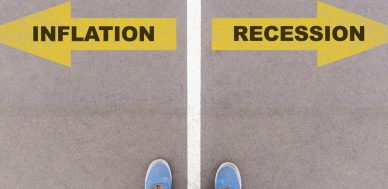To Figure Out Where U.S. Economy Is Headed, Don’t Overlook This Indicator
Warning: the U.S. economy is in dangerous territory. A severe recession could be just around the corner. Don’t be shocked if 2023 goes down in the books as a year with one of the sharpest declines in growth that the U.S. economy has ever seen. Obviously, this is bad news for investors, so later I’ll discuss how to protect your savings.
Before I get into that, there’s one economic indicator that shouldn’t be overlooked: yield curve. This indicator essentially shows us how the yields on long-term and short-term bonds look.
There are two main things you should know about yield curve.
First, when the yield curve is trending upward, it means yields on long-term bonds are higher than the yields on short-term bonds. An upward-trending yield curve, which economists call “normal,” means economic growth is ahead. Second, when the yield curve is trending downward, it means that yields on short-term bonds are higher than the yields on long-term bonds. This is when investors should be cautious. A downward-trending yield curve, which economists call “inverted,” foretells a recession.
Over the past few decades, yield curve has been extremely accurate in predicting recessions. Whenever the curve has inverted, a recession in the U.S. economy has followed within 12 months.
Yield Curve Says U.S. Economy Could Be Headed for Great Recession
With all this said, look at the following chart. It plots the difference in yield between the 10-year U.S. Treasury bond and the two-year U.S. Treasury bond.
Chart courtesy of Stockcharts.com
As you can see in the above chart, the yield curve plotting the 10-year and two-year bonds is extremely inverted and in negative territory. This yield curve hasn’t been this inverted in a few decades (at least). Scary.
Now look at the following chart. It plots the difference in yield between the 10-year U.S. Treasury bond and the three-month U.S. Treasury bond.
Chart courtesy of Stockcharts.com
The difference in yield between the 10-year bond and the three-month bond is the lowest it has been since the early 2000s. This yield curve is extremely inverted, and since this type of indicator has a very good track record in forecasting recessions, it would be foolish to overlook it.
The yield curve says an economic slowdown like the Great Recession of 2007–2009 could become a reality for the U.S. economy in 2023.
In 2022, the U.S. economy saw lots of deceleration. In 2023, the economy could enter a deterioration stage. This stage is when we would see mass layoffs, dismal consumer spending, pessimistic businesses, and so on. This is essentially what the Federal Reserve could be wishing for. Why? Because it could be the only way to curb the inflation that’s been sticking around. When demand is destroyed, inflation eventually gets under control.
What Investors Should Know About the Economy
As just mentioned, the U.S. economy has been primarily in a deceleration stage in 2022. As this has happened, profits at companies were relatively fine. Corporate America was able to pass their higher costs on to consumers.
However, be very mindful of what happens when businesses aren’t able to pass on further costs to consumers, their debt expenses stay high as interest rates remain elevated, and overall economic conditions deteriorate. One could say it’s a train wreck waiting to happen. Corporate profits could plummet, which would likely be bad news for the stock market.
For the fourth quarter of 2022, Wall Street analysts expect the earnings of S&P 500 companies to decline by 2.1%. For the entire year of 2023, analysts expect S&P 500 companies to report earnings growth of just 1.6%. (Source: “Earnings Insight,” Factset Research Systems Inc., November 18, 2022.)
Note that Wall Street analysts tend to be optimistic with their estimates, so these estimates could go down within a few months.
Moreover, the bond market could become an interesting place. Bond investors seem to be running with the idea that interest rates won’t remain high for long. But short-term interest rates are seeing black swan event-like activity.
As all this materializes, it’s important that investors don’t get complacent. They should continue to focus on preserving capital, be selective when it comes to picking investments, and have stop-losses in place to protect against bigger losses.
